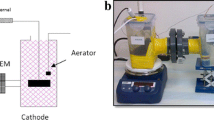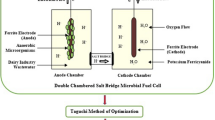Abstract
In the present study, the performance of dual chamber microbial fuel cells (MFC) was investigated employing sludges collected from drains, a textile effluent treatment plant, and the Buriganga river as the sources of microbes, while a mixed liquor prepared from dustbin waste and gruel was used as substrates for the growth of bacteria. Six experiments were carried out under aerobic conditions throughout the study and inspected for seven days. Agar salt bridge was used instead of the typical membrane for proton exchange. For analyzing the electrical parameters of the MFCs such as voltage, current density and power density were recorded for each experiment. Reduction of Biological Oxygen Demands (BOD5) of the sludges was also observed in this study. Regarding electrical performance, the Buriganga sludge afforded the best results demonstrating maximum voltage, current density, and power density as 244.88 mV, 35.16 mA/m2, and 8.61 mW/m2, respectively. However, the BOD5 reduction was found to be 50.15%, 43.64%, 47.32%, and 35.20% for sludges collected from a drain of a residential area, a textile effluent treatment plant, a tannery, and the Buriganga river, respectively. Counts of aerobic Escherichia coli and Bacillus subtilis in different sludges were also documented.











Similar content being viewed by others
References
Liu L, Peng Y, Zhang W, Ma X (2023) Concept of rapid and controllable combustion for high power-density diesel engines. Energy Convers Manage 276:116529. https://doi.org/10.1016/j.enconman.2022.116529
Ng F-L, Jaafar MM, Phang SM, Chan Z, SallehNA Azmi SZ, Yunus K, Fisher AC, Periasamy V (2014) Reduced graphene oxide anodes for potential application in algae biophotovoltaic platforms. Sci Rep 4:7562. https://doi.org/10.1038/srep07562
Liu L, Wu Y, Wang Y, Wu J, Fu S (2022) Exploration of environmentally friendly marine power technology-ammonia/diesel stratified injection. J Clean Prod 380:135014. https://doi.org/10.1016/j.jclepro.2022.135014
Ahmad QA, Qazi JI (2014) Int J Energy Environ Eng 5:94. https://doi.org/10.1007/s40095-014-0094-4
Nasirahmadi S, Akbari-adergani B (2018) Int J Energy Environ Eng 9:249
Sirinutsomboon B (2014) Modeling of a membraneless single-chamber microbial fuel cell with molasses as an energy source. Int J Energy Environ Eng 5:1–9
Gatti MN, Milocco RH (2017) Int J Energy Environ Eng 8:303. https://doi.org/10.1007/s40095-017-0249-1
Ren H, Lee H-S (2012) JChae, Miniaturizing microbial fuel cells for potential portable power sources: promises and challenges. Microfluid Nanofluid 13(3):353–381
Lovley DR (2008) Extracellular electron transfer: wires, capacitors, iron lungs, and more. Geobiology 6(3):225–231
Logan BE, Hamelers B, Rozendal R, Schroder U, Keller S, Freguia J, Aelterman P, Verstraete W, Rabaey K (2006) Microbial fuel cells: methodology and technology. Environ Sci Technol 40:5181–5192
Virdis B, Freguia S, Rozendal RA, Rabaey K, Yuan Z, Keller J (2011) Microbial fuel cells. Elsevier Science publisher, Amsterdam
Rahimnejad M, Ghasemi M, Najafpour GD, Ghoreyshi A, Bakeri G, Hassaninejad K, Talebnia F (2012) Acetone removal and bioelectricity generation in dual chamber Microbial Fuel Cell. Am J Biochem Biotech 8:304–310
Rahimnejad M, Najafpour G, Ghoreyshi AA (2011) Effect of mass transfer on performance of microbial fuel cell. Mass Trans Chem Eng Proc 5:233–250
Hassan SH, El-Rab S, Rahimnejad M, Ghasemi M, Joo J, Ok Y, Kim I, Oh S (2014) Electricity generation from rice straw using a microbial fuel cell. Int J Hydro Eng 39:9490–9496
Zhou Y, Wang B, Ling Z, Liu Q, Fu X, Zhang Y, Zhang R, Hu S, Zhao F, Li X, Bao X, Yang J (2024) Advances in ionogels for proton-exchange membranes. Sci Total Environ 921:171099. https://doi.org/10.1016/j.scitotenv.2024.171099
Zhang Y, Wu MX, Zhou G, Wang XH, Liu X (2021) A rising star from two worlds: collaboration of COFs and ILs. Adv Funct Mater 31(40):2104996. https://doi.org/10.1002/adfm.202104996
Park DH, Zeikus JG (2000) Electricity generation in microbial fuel cells using neutral red as an electronophore. Appl Environ Microb 66:1292–1297
Oh SE, Logan BE (2005) Hydrogen and electricity production from a food processing wastewater using fermentation and microbial fuel cell technologies. Water Res 39:4673–4682
Suzuki S, Karube I (1984) Energy production with immobilized. Cells Appl Biochem Bioeng 4:281–310
Higgins SR, Lau C, Plamen A, Minteer SD, Cooney MJ (2011) Hybrid biofuel cell: microbial fuel cell with an enzymatic air-breathing cathode. ACS Catal 1(9):994–997. https://doi.org/10.1021/cs2003142
Bond DR, Holmes DE, Tender LM, Lovley DR (2002) Electrode-reducing microorganisms that harvest energy from marine sediments. Science 295:483–485
Wang S, McGrath JE (2003) Synthesis of poly(arylene ether)s.Synthetic Methods in Step-Growth Polymers. Wiley: New York, pp 327
Uddin SS, Mahmood ZH, Nurnabi M (2018) Performance analysis of a dual chamber microbial fuel cell using kitchen wastes as substrate. 2018 International Conference on Innovation in Engineering and Technology (ICIET). https://doi.org/10.1109/CIET.2018.8660915
Sarker S, Chowdhury MB, Riyadh SS, Hossain T, Uddin HS, Syfuddin HM (2017) A mediator-less double chambered microbial fuel cell using sewerage sludge with output of relatively higher voltage and higher efficiency. Biores Commun 3(2):420–427
Min B, Cheng S, Logan BE (2005) Electricity generation using membrane and salt bridge microbial fuel cells. Water Res 39(9):1675–1686. https://doi.org/10.1016/j.watres.2005.02.002
Khan MR, Bhattacharjee R, Amin MSA (2012) Performance of the salt bridge based microbial fuel cell. Int J Eng Technol 1(2):115–123
Sivakumar D (2021) Wastewater treatment and bioelectricity production in microbial fuel cell: salt bridge configurations. Int J Environ Sci Technol 18(6):1379–1394. https://doi.org/10.1007/s13762-020-02864-0
Bose D, Bose A, Kundani D, Gupta D, Jain H (2018) Comparative analysis of carbon cloth and aluminum electrodes using agar salt-bridge based microbial fuel cell for bioelectricity generation from effluent derived wastewater. 17(4):1201–1205
Zhang Y, Liu M, Zhou M et al (2019) Microbial fuel cell hybridsystems for wastewater treatment and bioenergy production: synergistic effects, mechanisms and challenges. Renew Sust Energy Rev 103:13–29
Huggins T, Wang H, Kearns J, Jenkins P, Ren ZJ (2014) Biochar as a sustainable electrode material for electricity production in microbial fuel cells. Bioresource Technol 157:114–119
Bettin C (2006) Applicability and feasibility of incorporating microbial fuel cell technology into implantable biomedical devices. Dissertation, The Ohio State University
Jung S, Regan JM (2007) Comparison of anode bacterial communities and performance in microbial fuel cells with different electron donors. Appl Microbiol Biot 77:393–402
Rahimnejad M, Mokhtarian N, Najafpour G, Daud W, Ghoreyshi A (2009) Low voltage power generation in a biofuel cell using anaerobic cultures. World Appl Sci J 6:1585–1588
Nevin KP, Richter H, Covalla SF, Johnson JP, Woodard TL, Orloff AL, Jia H, Zhang M, Lovley DR (2008) Power output and columbic efficiencies from biofilms of Geobacter sulfurreducens comparable to mixed community microbial fuel cells. Environ Microbiol 10:2505–2514
Park DH, Zeikus JD (2002) Improved fuel cell and electrode designs for producing electricity from microbial degradation. Biotechnol Bioeng 81:348–355
Zhou M, Chi M, Luo J, He H, Jin T (2011) An overview of electrode materials in microbial fuel cells. J Power Sources 196:4427–4435
Chen GW, Choi SJ, Lee TH, Lee GY, Cha JH, Kim CW (2008) Application of biocathode in microbial fuel cells: cell performance and microbial community. Appl Microbiol Biot 79:379–388
Ghasemi M, Daud WRW, Rahimnejad M, Rezayi M, Fatemi A, Jafari Y, Somalu M, Manzour A (2013) Copper phthalocyanine and nickel nanoparticles as novel cathode catalysts in microbial fuel cells. Int J Hydrog Energy 38:9533–9540
Park D, Zeikus J (2002) Impact of electrode composition on electricity generation in a single-compartment fuel cell using Shewanellaputrefaciens. Appl Microbiol Biot 59:58–61
Ren H, Jiang C, Chae J (2017) Effect of temperature on a miniaturized microbial fuel cell (MFC). Micro Nano Syst Lett 5:13
Wang XL, Wu C, Zhang JQ et al (2011) Acclimation stage on the performance of microbial fuel cells subjected to variation in COD, temperature, and electron acceptor. In: Advanced Materials Research, pp 2346–2350
Santoro C, Arbizzani C, Erable B, Ieropoulos I (2017) Microbialfuel cells: from fundamentals to applications. A review. J Power Sources 356:225–244
Gadkari S, Fontmorin JM, Yu E, Sadhukhan J (2020) Influence of temperature and other system parameters on microbial fuel cell performance: numerical and experimental investigation. Chem Eng J 388:124–176
Gonzalez del Campo A, Lobato J, Cañizares P et al (2013) Short term effects of temperature and COD in a microbial fuel cell. Appl Energy 101:213–217
Commault AS, Barrière F, Lapinsonnière L et al (2015) Influence of inoculum and anode surface properties on the selection of Geobacter-dominated biofilms. Bioresour Technol 195:265–272
Patil SA, Harnisch F, Kapadnis B, Schröder U (2010) Electroactive mixed culture biofilms in microbial bioelectrochemical systems: the role of temperature for biofilm formation and performance. Biosens Bioelectron 26:803–808
Li J (2013) An experimental study of microbial fuel cells for electricity generating: performance characterization and capacity improvement. J Sustain Bioenergy Syst 3:171–178
Zhang Y, Sun J, Hu Y, Wang Z, Li S (2014) Effects of periodically alternating temperatures on performance of single-chamber microbial fuel cells. Int J Hydrogen Energy 39(15):8048–8054
Wei L, Han H, Shen J (2013) Effects of temperature and ferrous sulfate concentrations on the performance of microbial fuel cell. Int J Hydrogen Energy 38(25):11110–11116
Almatouq A, Babatunde AO (2016) Concurrent phosphorus recovery and energy generation in mediator-less dual chamber microbial fuel cells: mechanisms and influencing factors. Int J Environ Res Public Health 13:375. https://doi.org/10.3390/ijerph13040375
Rahimnejad M, Adhami A, Darvari S et al (2015) Microbial fuel cell as new technology for bioelectricity generation: a review. Alexandria Eng J 54:745–756
Habermann W, Pommer EH (1991) Biological fuel cells with sulphide storage capacity. Appl Microbiol Biotechnol 35:128–133
Deng Q, Li X, Zuo J, Ling A, Logan BE (2009) Power generation using an activated carbon fiber felt cathode in an upflow microbial fuel cell. J Power Sources 195:1130–1135
TerHeijne A, Hamelers HVM, De Wilde V, Rozendal RA, Buisman CJN (2006) A bipolar membrane combined with ferric iron reduction as an efficient cathode system in microbial fuel cell. Environ Sci Technol 40:5200–5205
Tang X, Guo K, Du Z, Tian J (2010) Microfiltration membrane performance in two-chamber microbial fuel cells. Biochem Eng J 52:194–198
Sun J, Hu Y, Bi Z, Cao Y (2009) Improved performance of air-cathode single-chamber microbial fuel cell for wastewater treatment using microfiltration membranes and multiple sludge inoculation. J Power Sources 187:471–479
Ren J, Li N, Du M, Zhang Y, Hao C, Hu R (2021) Study on the effect of synergy effect between the mixed cultures on the power generation of microbial fuel cells. Bioengineered 12(1):844–854. https://doi.org/10.1080/21655979.2021.1883280
Acknowledgements
The authors want to convey gratitude towards the Department of Applied Chemistry and Chemical Engineering, Semiconductor Technology Research Centre (STRC), and Department of Botany and Centre for Advanced Research for Sciences (CARS) of the University of Dhaka for laboratory supports.
Author information
Authors and Affiliations
Contributions
Sheikh Shehab Uddin: conducting experimental studies, formal analysis, and writing draft manuscript. Md. Mahidul Haque Prodhan: manuscript proofreading and editing draft manuscript. Mohammad Nurnabi: conceptualization, formal analysis, editing draft manuscript, and supervision.
Corresponding author
Ethics declarations
Conflict of interest
The authors declare no competing interests.
Additional information
Publisher's Note
Springer Nature remains neutral with regard to jurisdictional claims in published maps and institutional affiliations.
Rights and permissions
Springer Nature or its licensor (e.g. a society or other partner) holds exclusive rights to this article under a publishing agreement with the author(s) or other rightsholder(s); author self-archiving of the accepted manuscript version of this article is solely governed by the terms of such publishing agreement and applicable law.
About this article
Cite this article
Uddin, S.S., Prodhan, M.M.H. & Nurnabi, M. Studies on agar salt bridge based dual chamber microbial fuel cells using sludge and dustbin waste. Biomass Conv. Bioref. (2024). https://doi.org/10.1007/s13399-024-05718-8
Received:
Revised:
Accepted:
Published:
DOI: https://doi.org/10.1007/s13399-024-05718-8




